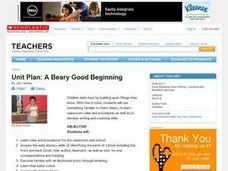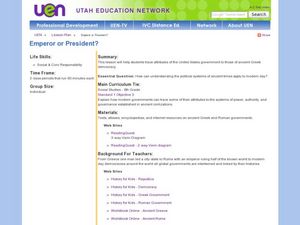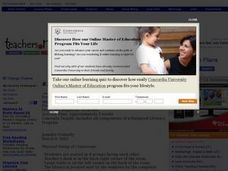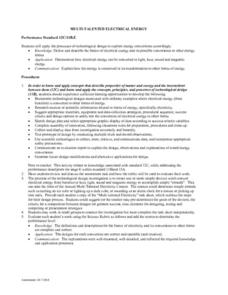EngageNY
The Relationship Between Visual Fraction Models and Equations
Ours is to wonder why, not just to invert and multiply. The seventh installment of a 21-part module uses fraction models to help pupils understand why the invert-and-multiply strategy for dividing fractions works. They then work on some...
PBS
Journalism Ethics
As a journalist, would you publish everything you heard or saw? Discuss the ethics of journalism with a lesson from PBS. Young reporters imagine themselves to be the editor of their school's newspaper, and as they read five scenarios,...
College Board
AP® Computer Science A: Elevens Lab Student Guide
Looking for a project to use in an AP® Computer Science class? Engage learners with a simple solitaire game called Elevens. Through these activities, learners break down the task and write the code for a game. Sign in to your College...
Baylor College
Food for Kids
Immediately capture the attention of your class with the smell of freshly popped popcorn in the sixth activity of this series on the needs of living things. Young scientists first use their senses to make and record observations of...
University of California
Seasons Lab Book
Unlock the mystery behind seasonal change with a collection of worksheets and activities. Whether they are drawing pictures of Earth's orbit around the sun or graphing the temperature and daylight hours of different locations from around...
Curated OER
Dilworth Elementary Character Education Respect (September)
R-e-s-p-e-c-t, find out what it means to your class! After a grand conversation about what is, and how one can show respect, scholars take part in a plethora of activity choices such as role playing, a game of Simon Says, wood working,...
Cornell University
Bridge Building
Bridge the gaps in your knowledge of bridges. Individuals learn about bridge types by building models. The activity introduces beam bridges, arch bridges, truss bridges, and suspension bridges.
101 Questions
Super Stairs
Keep your classes climbing in the right direction. Young mathematicians collect data from a video presentation. Using their data, they build an arithmetic sequence and use it to make predictions.
Deliberating in a Democracy
Parental Liability
How many teenagers have wanted their parents to let them make their own decisions? The answer is ... all of them! Scholars investigate where parental liability begins and ends in the eyes of the law. Using case studies and legal...
National History Day
Challenging the Status Quo: Women in the World War I Military
Why are some so resistant to change? The status quo is often to blame for a lack of forward movement in society. Following the events of World War I, women in America suddenly had a voice—and were going to use it. Scholars use the second...
Missouri Department of Elementary
My Feelings
Encourage self-awareness with a lesson that challenges scholars to identify feelings—happy, sad, mad, and scared. Using a feelings thermometer, similar to that of a bar graph, pupils discuss how they would feel in specific scenarios then...
Curated OER
A Beary Good Beginning
Students complete first day of school activities. Through instructor modeling and demonstration, they become acquainted with the rules and procedures for the classroom and school. Students create a book of their first day experience.
Curated OER
All About Me & the School Experience
Students create a book documenting their school experience. After completing a class read of "Clifford's First School Day," students discuss what it is like being at school. They use a book template to create their own first days of...
Curated OER
Emperor or President?
Sixth graders complete a Venn Diagram. In this government comparison lesson plan, 6th graders discuss how rules are similar and different at home, school and in their community. Students learn about the type and structure of the United...
Curated OER
Understanding The Preamble
Students explore the Preamble of the U.S. Constitution. In this government instructional activity, students write a preamble to encourage cooperation in their classroom as they study the Preamble of the U.S. Constitution.
Curated OER
Using Words to Work Things Out
Students use appropriate words to resolve a conflict or a problem. For this appropriate words lesson plan, students participate in a role play, building a puzzle, and creating a good classroom environment and use words that are...
Curated OER
A Little Kandinsky For All
Learners create abstract compositions based on the later works of Wassily Kandinsky using the primary colors in this early elementary Art lesson. The lesson emphasizes the use of color, lines, and shapes to create the abstract works of...
Curated OER
Families and Neighborhoods
Students create a poster representative of their community. In this lesson on the world around them, students learn about their neighborhood. After they have gathered some knowledge about the objects and people in their community,...
Curated OER
Balanced Literacy: Presidents
Pupils participate in a unit (all lessons on the same page) to explore the Presidents of the United States. They choose one President to write a mini-book about, create a puppet and an original puppet show to perform about their chosen...
Curated OER
Multi-Talented Electrical Energy
Students explore energy conversions by demonstrating the conversion of electrical energy into light, heat, sound, and magnetic energy. Students create a simple device that converts electrical energy from batteries to heat, light, sound...
Curated OER
Ideas for Activities and Discussions About the U.S. Constitution
Incorporating lessons about the foundation of the U.S. Constitution can invigorate the minds of students.
Curated OER
Making Learning a Game
A game lesson can be a way to explore a variety of concepts with your students.
Curated OER
Let's Play Scrabble!
What do Alfred Mosher Butts, James Brunot, and Jack Straus have in common? They were all instrumental in the development of Scrabble. Class members will discover these facts and many more as they conduct a WebQuest to gather, organize,...
Curated OER
Lab Safety
Teaching the importance of safety in the science laboratory is a necessary part of the curriculum.

























